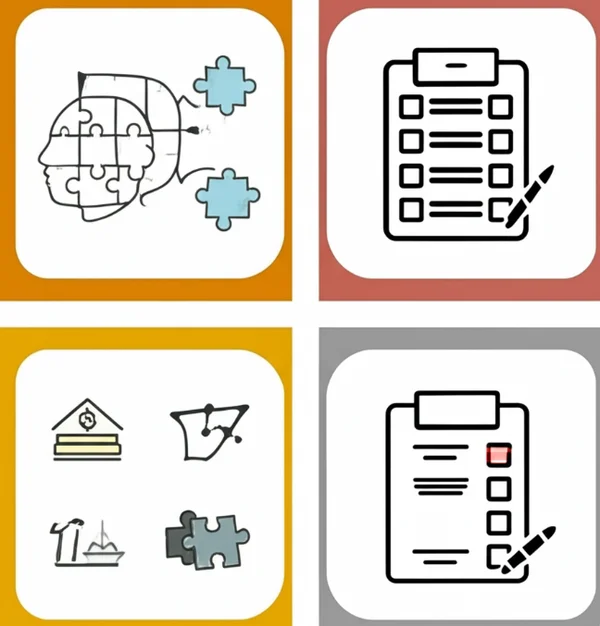RAADS-R & ADHD: Navigating Symptom Overlap in Adults
May 23, 2025 | By Elara Vance
For many adults exploring their neurodivergent traits, the journey can lead to questions about both Autism Spectrum Disorder (ASD) and Attention-Deficit/Hyperactivity Disorder (ADHD). You might be using tools like the RAADS-R test to understand potential autistic characteristics and wondering, "do people with adhd score high on raads?" This article dives into the intricate relationship between the RAADS-R test and ADHD autism presentations in adults, exploring the common autism adhd overlap, how ADHD might influence your RAADS-R score, and why a nuanced understanding is crucial. Our goal at raads-r.net is to provide clarity as you navigate these complex conditions.
What is AuDHD? Understanding the Autism ADHD Overlap in Adults
The term "AuDHD" has gained traction to describe individuals who experience characteristics of both Autism (ASD) and ADHD. Understanding this autism adhd overlap in adults is the first step to making sense of sometimes contradictory or intensified traits. What are the overlapping symptoms of autism and adhd in adults?
Defining Neurodiversity and Co-occurring Conditions
Neurodiversity is a concept that recognizes and respects neurological differences as natural human variations. Within this framework, it's common for individuals to have co-occurring conditions, meaning they experience traits associated with more than one neurodevelopmental profile. ASD and ADHD are two such conditions that frequently co-occur. It's estimated that a significant percentage of autistic individuals also meet the criteria for ADHD, and vice-versa. This highlights why clear differentiating autism and adhd can be challenging without professional input.

Common Shared Symptoms: Social Challenges, Executive Dysfunction, Sensory Sensitivities, and Emotional Regulation
The confusion between ASD and ADHD in adult adhd autism presentations often stems from shared surface-level symptoms:
- Social Challenges: Both autistic individuals and those with ADHD can struggle with social interactions. However, the underlying reasons often differ. An autistic person might struggle with interpreting nonverbal cues or understanding implicit social rules, leading to social anxiety or withdrawal. Someone with ADHD might appear inattentive in conversations, interrupt frequently due to impulsivity, or miss social cues due to distractibility, leading to similar interpersonal difficulties.
- Executive Dysfunction: This is a hallmark of ADHD but is also very common in autism. Difficulties with planning, organizing, initiating tasks, time management, working memory, and flexible thinking (executive dysfunction) can significantly impact daily life for individuals with either or both conditions.
- Sensory Sensitivities: Both groups can experience sensory sensitivities. Autistic individuals might experience sensory overload from bright lights, loud noises, or certain textures, leading to a need to withdraw or engage in stimming (self-stimulatory behaviors) to regulate. Individuals with ADHD might also be sensitive to stimuli or, conversely, be sensory-seeking, needing more intense input to feel regulated or maintain focus.
- Emotional Regulation: Difficulties with emotional regulation are prevalent in both ASD and ADHD. This can manifest as intense emotional responses, difficulty managing frustration, or mood swings. The reasons and internal experiences might differ, but the outward expression can appear similar.
Understanding these overlaps is crucial before considering how an RAADS-R score adhd interaction might play out.
How ADHD Symptoms Might Influence Your RAADS-R Score
Given the symptom overlap, it's logical to ask how ADHD symptoms might specifically affect responses on the RAADS-R test, which is designed to screen for autistic traits. Can raads-r test detect adhd? The direct answer is no, but ADHD can influence the score.
Social Interaction Questions: ADHD Impulsivity vs. Autistic Social Differences
Several RAADS-R questions explore social interaction. For instance, a question about difficulty in conversations could be endorsed by someone with ADHD due to impulsivity (e.g., interrupting, talking excessively) or inattention, leading them to miss parts of the conversation. An autistic individual might endorse the same question due to difficulties with reciprocal conversation, understanding social nuances, or social anxiety. Thus, ADHD traits can lead to answers that align with the scoring for autistic traits on certain questions.
Attention and Focus: Distractibility in ADHD and Intense Interests in Autism
The RAADS-R touches upon patterns of attention and focus. While ADHD is characterized by distractibility and difficulty sustaining attention (unless on a highly stimulating task), autism is often associated with intense, narrow interests or "hyperfocus." Some RAADS-R questions about being absorbed in details or specific topics might be endorsed by individuals with ADHD if the topic is one of their fleeting hyperfixations, potentially leading to a higher score in the "circumscribed interests" domain of the RAADS-R test.
Sensory Processing: ADHD Sensory Seeking vs. Autistic Sensory Overload/Avoidance
Questions related to sensory processing on the RAADS-R typically probe for sensitivities and aversions common in autism (e.g., discomfort with certain sounds, textures). While some individuals with ADHD also experience sensory sensitivities, others might be sensory seeking (e.g., needing constant movement, loud music). However, if an ADHD individual experiences sensory overwhelm due to difficulty filtering stimuli (a common ADHD trait), their answers might align with those typical of autistic sensory overload or avoidance, thus influencing their raads-r score adhd profile.

The RAADS-R Test is for Autism Traits, Not an ADHD Diagnostic Tool
It's paramount to understand that the RAADS-R test is specifically designed to screen for autism traits. It is not validated or intended as an ADHD diagnostic tool.
What the RAADS-R Test Measures Specifically
The RAADS-R focuses on developmental history related to social communication, social interaction, repetitive behaviors, and sensory issues as they manifest in ways characteristic of autism. Its questions are framed to capture these specific nuances. While some resulting behaviors might look similar to ADHD behaviors on the surface, the underlying neurocognitive mechanisms and developmental trajectories it aims to assess are rooted in the current understanding of autism.
Why a Separate, Comprehensive ADHD Assessment is Necessary
If ADHD is suspected, either alone or alongside autism (AuDHD), a separate, comprehensive ADHD assessment by a qualified professional is essential. This typically involves clinical interviews, rating scales specifically for ADHD (completed by the individual and often by someone who knows them well), a review of developmental history focusing on ADHD symptoms, and an assessment of impairment across different life domains. Relying on an autism screener like the RAADS-R to infer an ADHD diagnosis would be inappropriate and potentially misleading.

Differentiating Autism and ADHD in Adults: Key Considerations for a Clearer Picture
While challenging, differentiating autism and ADHD in adults is possible, especially with professional guidance. Here are some key considerations:
Core Motivations Behind Behaviors (e.g., Social Avoidance vs. Social Inattention)
Understanding the why behind a behavior is often more telling than the behavior itself. For example, social challenges might manifest as difficulty in group conversations. For an autistic individual, this might stem from difficulty processing multiple inputs, understanding implied rules, or sensory overwhelm leading to social avoidance. For an individual with ADHD, it might be due to social inattention, impulsively changing topics, or difficulty waiting their turn.
Developmental History and Onset of Symptoms
A thorough developmental history is crucial. While both ASD and ADHD are neurodevelopmental conditions present from early childhood, the specific nature and timing of early symptoms can offer clues. For example, early language delays or unusual language development are more characteristic of autism, while significant, pervasive hyperactivity/impulsivity from a young age is a hallmark of ADHD.
The Role of a Clinician in Untangling Overlapping Traits and Considering AuDHD
Ultimately, a skilled clinician experienced in assessing both ASD and ADHD in adults is best equipped for untangling overlapping traits. They can use a battery of assessments, conduct in-depth interviews, and consider the full picture to arrive at an accurate diagnosis, including the possibility of AuDHD. Is there a test for audhd? Not a single one; it involves assessing for both conditions.

Navigating Self-Assessment When Suspecting AuDHD
If you suspect you might have characteristics of both autism and ADHD (AuDHD), self-assessment can still be a useful starting point for your journey.
Using the RAADS-R Test as One Piece of the Puzzle for Autism Insights
You can use the RAADS-R test available on raads-r.net to explore potential autistic traits. View the results as one set of data points in your broader self-assessment process.
Considering ADHD-Specific Screeners Alongside the RAADS-R
Alongside the RAADS-R, consider using reputable, free online ADHD screeners for adults. Comparing results from different types of screeners might offer a more rounded, though still non-diagnostic, perspective.
The Value of Journaling and Observing Personal Patterns in Daily Life
Beyond tests, journaling your experiences, triggers, challenges, and strengths related to social situations, executive functioning, sensory input, and emotional regulation can be incredibly insightful. Observing personal patterns over time provides rich, qualitative data that screeners alone cannot capture. This self-awareness is invaluable, regardless of any formal labels.

RAADS-R, ADHD, and You: Seeking Clarity in Neurodiversity
The relationship between the RAADS-R test, ADHD autism presentations, and the experience of AuDHD is complex. While the RAADS-R is a valuable tool for exploring autistic traits, it's crucial to understand that co-occurring ADHD can influence scores. This doesn't invalidate the RAADS-R but highlights the need for careful interpretation and, importantly, comprehensive professional assessment if you suspect you have ADHD, autism, or both. Embracing your neurodiversity starts with understanding, and tools like the RAADS-R can be a helpful part of that journey towards clarity.
What are your thoughts or experiences with the overlap between autism and ADHD? How have self-assessment tools helped you? Share in the comments below!
RAADS-R Test, ADHD, and AuDHD Explained
-
Do people with ADHD typically score high on the RAADS-R test?
It's possible for individuals with ADHD to score higher on the RAADS-R test due to overlapping symptoms like social challenges, executive dysfunction, or sensory sensitivities, even if they don't have autism. This is why a raads-r score adhd consideration is important, and the test shouldn't be used in isolation if multiple conditions are suspected.
-
Can the RAADS-R test tell me if I have ADHD or AuDHD?
No. The RAADS-R test is designed to screen for traits associated with Autism Spectrum Disorder, not ADHD. To explore ADHD, specific ADHD screening tools and a professional assessment are necessary. For suspected AuDHD, evaluations for both conditions by a qualified professional are needed.
-
What are some key differences in adult symptoms between autism and ADHD?
While there's autism adhd overlap, key differences often lie in the underlying reasons for behaviors. For example, social difficulties in autism might stem from challenges in understanding social cues or sensory overload, while in ADHD they might be due to impulsivity or inattention. Repetitive behaviors in autism are often for self-regulation or due to intense interests, whereas restlessness in ADHD is more about a need for movement or difficulty with sustained stillness.
-
If I suspect I have both autism and ADHD (AuDHD), what should my first step be?
A good first step could be to use self-assessment tools like the RAADS-R for autism traits (you can take our RAADS-R test here) and a separate adult ADHD screener. Document your experiences and then seek a comprehensive evaluation from a professional experienced in diagnosing both conditions in adults.
-
How does a high RAADS-R score relate to a potential ADHD diagnosis?
A high RAADS-R score primarily suggests the presence of autistic traits. If you also have ADHD, some ADHD symptoms might have contributed to that higher score due to symptom overlap. It doesn't mean the RAADS-R diagnosed ADHD, but rather that a comprehensive assessment is needed to differentiate and understand the full picture of your adult adhd autism profile.